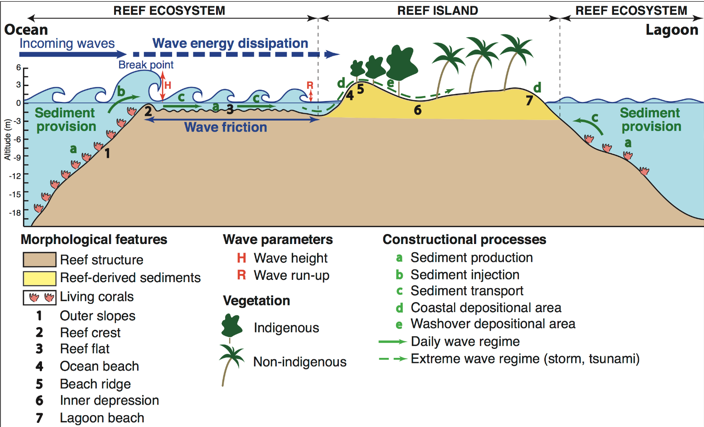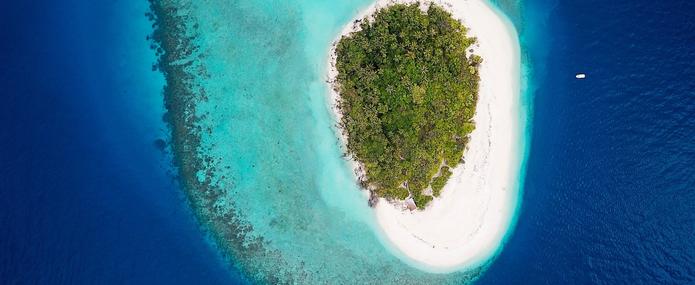A recent scientific paper by IDDRI and LIENSs (La Rochelle University-CNRS) published in Nature Scientific Reports demonstrates the major contribution of human activities to the undermining of the natural capacity of the Maldivian islands to adjust to ocean changes, and therefore to increasing coastal risks in this country. It calls for diversified island-type based adaptation pathways.
The undermining of the coastal protection service
The IPCC Special Report on Ocean and Cryosphere in a Changing Climate (SROCC) brings new evidence on the impacts of climate change on the ocean, including ocean warming, acidification and deoxygenation, and sea-level rise. Expected consequences are huge for ecosystems and human societies, especially in tropical areas. Keystone ecosystems such as warm-water coral reefs will face high to very high risks by the end of this century even under a low greenhouse gas emission scenario, and more ecosystems including mangroves and sandy beaches will reach such risk levels if emissions go higher. The frequency of large-scale coral bleaching events is for example expected to intensify in the coming decades. What is at stake, among other things, is the undermining of the coastal protection service provided by the atoll reef-island system (i.e. coral reef + island itself, see Figure below), which may eventually render atoll islands uninhabitable due to sea-level rise. The coastal protection service essentially refers (1) to the reduction of marine flooding and coastal erosion (due to storm wave attenuation by the reef ecosystem and ocean-side beach), and (2) to the natural adjustment capacity of the island to rising sea levels through vertical building (due to sediment provision by the reef ecosystem). In addition, the SROCC concludes that unless ambitious adaptation efforts are undertaken, low-lying tropical coastal settlements such as urban atoll islands will face moderate to high risk by the end of this century even under a low emission pathway, and very high risk under the upper likely range of the RCP8.5 high emission scenario, i.e. +110 cm in 2100 compared to 1986-2005.
Figure. The coastal protection services of the reef-island system.
 Source: Duvat, V.K.E., Magnan, A.K. Rapid human-driven undermining of atoll island capacity to adjust to ocean climate-related pressures. Sci Rep 9, 15129 (2019) doi:10.1038/s41598-019-51468-3. Original picture: https://www.nature.com/articles/s41598-019-51468-3/figures/1.
Source: Duvat, V.K.E., Magnan, A.K. Rapid human-driven undermining of atoll island capacity to adjust to ocean climate-related pressures. Sci Rep 9, 15129 (2019) doi:10.1038/s41598-019-51468-3. Original picture: https://www.nature.com/articles/s41598-019-51468-3/figures/1.
Future risks will however do not only depend on the rate and extent of climate-related ocean changes and their associated hazards (e.g. storm surges and marine heat waves). Non-climatic drivers such as infrastructure development and human-induced environmental degradation have played a major role over the recent decades, and will continue to do so unless recent past trajectories of vulnerability are reverted or at least minimised. The paper published by IDDRI and LIENSs in Nature Scientific Report advances knowledge on the role played by human activities in undermining the natural capacity of reef islands to adjust to climate-related ocean changes, especially sea-level rise.
This paper uses the case of the Maldives, the most populated atoll nation in the world (>400,000 inhabitants in 2014), and is based on an original database including 608 islands representing more than half of the total number of islands and surface area of the country, as well as more than 85% of the total population. The results focus on the changes that operated over the last decade (from 2004-06 to 2014-16) and highlight, first, the rapidity and extent of human-induced changes that led to the substantial undermining of island natural capacity to respond to climate-related ocean changes. This partly results from the combination of major physical constraints (i.e. small and scattered islands), a dramatic demographic pressure (i.e. the country population doubled every ~25 years since the mid-1960s) and the successive governments’ willingness to equip inhabited islands with transport (i.e. mostly harbours, but also airports) and health (i.e. free clinics) facilities. While human-driven disturbances particularly reflect the situation of the inhabited and exploited islands (i.e. dedicated to tourism, agriculture, aquaculture, industry, and infrastructure) that are critical to the future habitability of this country, a dramatic decrease in the number of natural islands (due to the development of new activities or settlements) is also reported.
An anthropogenic tipping point?
Second, the results indicate that islands experienced different levels of undermining of the coastal protection service delivered by the reef-island system, and therefore that a diversity of island types need to be considered, from natural to little, moderately, highly and very highly disturbed islands (respectively 54.1%, 11.5%, 22.2%, 2.3% and 7.6% of the 608-island sample). As a result, the paper calls for the design of island type-based adaptation pathways rather than the one-size-fits-all strategies that tend to prevail in the international policy arenas. Enhancing context-relevant adaptation strategies is all the more important for atoll countries and territories that recent literature demonstrates that atoll island size mainly remained stable or increased over the last 4-5 decades, thus challenging the “shrinking island” generally accepted idea that often leads to promoting only one ultimate future for atoll populations, i.e. international migration. Although uncertainty about the future of atoll islands has to be considered, the paper argues that at this stage, there is still some space for adaptation, and that diverse island types requires diverse adaptation strategies.
Third, the results also suggest that islands increasingly and rapidly move from little-to-moderate to highly-to-very-highly disturbed types. That is, a path-dependency effect is operating at the national scale towards the increasing use of hard engineered protection structures to stabilise island shoreline and protect human assets (i.e. people, buildings, infrastructure and facilities, and economic activities) from the impacts of coastal erosion and marine flooding. Schematically, the greater the human pressure exerted on the shoreline and reef flat, the more the coastal protection service delivered by the reef-island system is undermined; and, as a result, the less the island is able to naturally adjust and adapt to climate-related ocean change, and the more human intervention is required to maintain islands, which are eventually locked in a “hard path”. The paper estimates that 20.1% and 46.2% of the inhabited and exploited islands of the Maldives have already reached or may reach in the near future an “anthropogenic tipping point” beyond which inhabited island armouring will be the only solution to maintain islands in the face of sea-level rise and extremes. Yet, there is high uncertainty on the future habitability of such armoured islands, which would lie below sea level and therefore likely be also affected by other hazards, e.g. saltwater intrusion.
This study provides the first nation-wide and island-scale assessment of the situation of an atoll country, making the findings of relevance beyond the case of the Maldives Islands. One overall conclusion is that in this country, which is representative of the situation of most of the densely-populated atoll islands in the world (e.g. Fongafale in Tuvalu, Majuro in the Marshall Islands or Rangiroa Atoll in the French Polynesian Tuamotu), human activities drove recent island change, and anthropogenic disturbances to natural island dynamics operated at a relatively rapid rate. As climate-related ocean change will exacerbate these issues, adaptation strategies are urgently needed to contain any additional detrimental path dependency, but the window for diversified adaptation is closing fast, at least in the Maldives.



